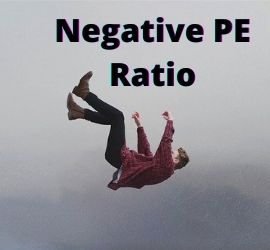Negative PE Ratio – What it Means
 A negative PE ratio (Price-to-Earnings) means that the company has negative earnings, or is losing money. While losing money is never a good thing, it is not always a bad thing either. It depends on a number of factors and requires a closer look.
A negative PE ratio (Price-to-Earnings) means that the company has negative earnings, or is losing money. While losing money is never a good thing, it is not always a bad thing either. It depends on a number of factors and requires a closer look.
The price-to-earnings (PE) ratio is a very common tool to determine if the price of a stock is cheap or expensive relative to its earnings. The ratio tells you how many dollars you must pay for each dollar of annual earnings. In general, a high PE ratio indicates that a stock is expensive. Conversely, a low PE ratio suggests that it is cheap or inexpensive.
However, this changes completely with a negative PE ratio. If earnings per share (EPS) are less than zero, then that causes the stock to have a negative PE ratio. A negative PE ratio can only mean that a stock has negative earnings. At some point, the company was losing money in the past 12 months. However, earnings per share are sensitive to various accounting methods, so it doesn’t always imply that a stock is a bad investment. It depends on many factors.
How Can you get a Negative PE Ratio?
The formula for the PE ratio is – PE = Stock Price / Earnings Per Share.
A stock’s price will never fall below $ 0 in value. As a result, the share price will never go negative. Therefore, the only reason a PE ratio can become negative is if earnings become negative. A negative PE ratio means that sometime during the past twelve months, the earnings of the company were negative. Negative profits are not something to be proud of, but they are not unheard of within the world of finance. Some major corporations have been unprofitable in some period of their lifespan. For example, Amazon consistently lost money for its first several years as a public company.
Negative earnings or negative EPS simply means that the company was not profitable and lost money over the measured point in time. There are several reasons why companies can experience negative profits over some time periods. That could be due to environmental changes that aren’t in control of the business, or any negative incidents within the business itself. Amazon intentionally posts low profits. Instead, it takes the vast majority of the money it earns and invests it right back into the company. The intention is to internally fund growth and generate even greater profits in the future.
Example of a Negative PE ratio
For example, the companies below each have a share price of $100. In other words, both of the companies’ shares cost $100 each.
- Company L (Loser) reported an EPS of -$0.5. To calculate the P/E ratio, divide the price ($100) by the EPS (-$0.5) to get a P/E ratio of -200. It is interesting to observe that an earning of -$0.5 per share, is not very far from breaking even.
- Company BL (Bigger Loser) reported an EPS of -$50. The price ($100) divided by EPS (-$50) gives a P/E ratio of -2. In this case, the company is far from breaking even. However, the company’s P/E ratio is not nearly as negative as company L’s.
In the upside-down world of negative numbers, having a high negative ratio is more favorable than having a less negative one. Conversely, having a lower positive ratio is more favorable than having a higher one.
In other words:
- A stock with a P/E ratio of 5 is cheaper than one with a ratio of 50.
- A stock with a negative P/E ratio of -50 is cheaper than one with a ratio of -5.
Clearly, there is much more to look at than just the P/E ratio by itself. You need to dig deeper to find the reason why the company has a negative P/E ratio.
Don’t be Confused
A negative PE ratio is particularly confusing because the significance of a big and small number is inverted. In other words, a very negative number is better than a number that’s just slightly negative. Let’s imagine two hypothetical stocks that each cost $100 per share. Company A has an EPS of -$100, which implies massive losses. But company B has an EPS of -$0.01, so it is on the verge of being profitable.
- Company A has a negative PE ratio of $100/-$100 = -1.
- Company B, which is on the verge of profitability, has a “sky-high” negative PE ratio of $100/-$0.01 = -10,000.
In this case, the bigger negative PE ratio is actually the better one. It means that the company’s losses are minimal. This is the opposite of a positive PE ratio, where a smaller number is generally seen as a good thing, while a bigger number implies that the stock is more expensive. (Source: stockanalysis.com)
Is a Negative PE Ratio Good or Bad?
Of course, a negative P/E ratio is not something any company wants. And, negative earnings are not something a company is actively looking to generate. A negative P/E implies that the business is currently not profitable and losing money. But, the real question becomes – is it only a temporary issue or a long-lasting one? Many good companies have posted negative earnings at some stage of their lifecycle. So, by itself, a negative P/E ratio doesn’t necessarily indicate a bad company. Companies that are operating within cyclical industries will more commonly have negative earnings depending on the business cycle of the company. You may often see companies that had a long record of continuously positive earnings but suddenly posted negative earnings for one single year. This may be due to an accounting write-off that will not occur again for some time – if ever.
However, it is a source of concern if you constantly see a negative PE ratio over several periods in a row. That might indicate that the underlying business is not being able to generate profits and returns to its investors. In any event, you shouldn’t just rely on the current PE ratio of a stock with no other analysis. A company in a cyclical industry can suddenly show a PE of 0 or a negative PE ratio. However, just because a business doesn’t state positive earnings for the given time period, it doesn’t necessarily imply that the business would be a bad investment. Using Amazon as an example, the company showed negative earnings for years when it first became publicly traded.
Negative PE Ratio – Most Financial Sites Show “n/a”
Most financial information websites don’t list the PE ratio if it’s negative. Instead, they show n/a, which means not applicable. Or, they may put nothing there at all, or a dash where the PE ratio is supposed to be. This is because a negative PE ratio is confusing. Finance and stock information websites can provide valuable information in other ways, such as by showing a negative net income or an EPS number.
Final Words
So should you invest in a stock with a negative P/E ratio? Maybe not, but it depends on other factors. The point is, you shouldn’t let a negative ratio automatically stop you from investigating. From an accounting standpoint, negative earnings don’t always mean that the company isn’t making any money. If you are looking for a real bargain, it might be a good idea to actually look at negative PE stocks. A little investigation might uncover something of value that has been dismissed due to the negative PE ratio.
In any event, always use the PE ratio in addition to other analytical tools. This will give you a more comprehensive look into the company’s financials. But, instead of just avoiding any stocks due to their PE ratio, you may want to take a deeper look. Examine the past record of PE ratios for the underlying company. Find the reason for the current incident. Then you can assess if that company only has a temporary issue or a bigger fundamental problem within the business.
Up Next: Semiannually – What Is Semiannual?
 Semiannually describes something that is calculated, paid, reported, published, or otherwise occurs twice each year or once every six months.
Semiannually describes something that is calculated, paid, reported, published, or otherwise occurs twice each year or once every six months.
Biannual or semiannual simply means that something occurs twice a year. For example, a company could have company celebrations semiannually. The first is the company picnic over the 4th of July Holiday weekend. The second is the company Christmas party held the last Saturday each year. If a family takes a summer holiday vacation and a winter holiday vacation, they do so semiannually. Anything that happens twice a year occurs semiannually.




